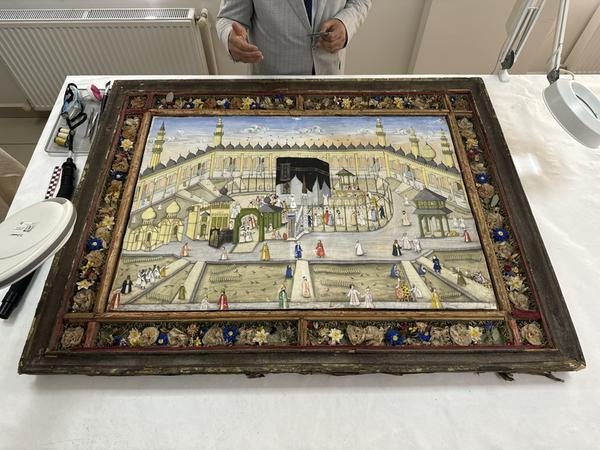
A rare 19th-century painting depicting the Masjid al-Haram and the Kaaba has been unearthed from the collections of Topkapı Palace and is undergoing meticulous restoration by Türkiye’s National Palaces Directorate.
The artwork, which has never been exhibited before, provides an intricate portrayal of the Kaaba and its surroundings, serving as a cultural and historical testament to the spiritual center of Islam. Once restoration is completed, expected within the next month, the painting will be put on public display.
Measuring 103 by 133 centimeters with its elaborate frame, the artwork is believed to date from the reign of Sultan Abdülmecid, based on the Ottoman military uniforms depicted. Though unsigned, the painting is a rich example of miniature-based Ottoman art, portraying pilgrims in ihram, women worshippers, Zamzam wells, the Station of Abraham (Maqam Ibrahim), Hijr Ismail, and the arcades designed by Mimar Sinan.
What makes the piece particularly valuable is its historical depth. Some of the architectural elements shown no longer exist today, making the work a visual archive of a bygone era. Human figures, rendered with distinct facial features, include both Anatolian and African characteristics, likely referencing the multicultural guardianship of the sacred sites by Ottoman officials, particularly those stationed in the palace’s "Kara Ağalar Courtyard," who were tasked with managing affairs related to the Hajj.
The painting's ornate frame is itself a work of art, crafted with three-dimensional floral decorations made of silk-wrapped wire, paper, and fabric. Red velvet panels with gilded borders and hand-forged nails reflect the craftsmanship of the time. Restoration efforts include cleaning, structural reinforcement and infrared analysis to uncover any hidden artist signatures or inscriptions.
"This painting not only shows the Kaaba as a religious focal point but also as a cultural memory site meant to be preserved and passed down through generations,” said Professor Abdülhamit Tüfekçioğlu, deputy head of the National Palaces Directorate.
“In Ottoman art, we begin to see new approaches to depicting the Kaaba and the sacred cities in the 17th and 18th centuries,” he said. “These included tile panels and calligraphic works featuring the Kaaba and Medina — especially in Hilye-i Saadet plaques, which describe the Prophet Muhammad’s appearance. Often, these images were integrated into decorative headings, and we can see both small inset illustrations and independent works becoming more frequent by the late 18th century.”
“Like earlier ceramic panels and calligraphic plaques depicting the holy sites, it reflects the Ottoman Empire’s deep spiritual and artistic engagement with the Hajj,” he noted.
Although no artist’s signature has yet been identified on the piece, researchers continue to examine the work using ultraviolet light and other methods in hopes of discovering hidden marks, dates, or names beneath the surface.